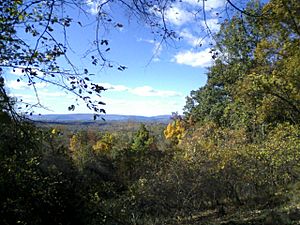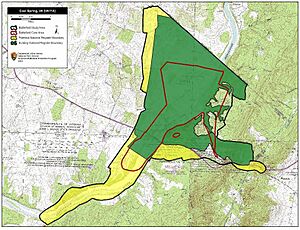Battle of Cool Spring facts for kids
Quick facts for kids Battle of Cool Spring |
|||||||
|---|---|---|---|---|---|---|---|
| Part of the American Civil War | |||||||
|
|||||||
| Belligerents | |||||||
| Commanders and leaders | |||||||
| Horatio G. Wright Joseph Thoburn |
Jubal A. Early John C. Breckinridge |
||||||
| Strength | |||||||
| 5,000 | 8,000 | ||||||
| Casualties and losses | |||||||
| 422 | 397 | ||||||
The Battle of Cool Spring was an important fight during the American Civil War. It happened on July 17-18, 1864, in Clarke County, Virginia. This battle was part of the Valley Campaigns of 1864. The Confederate side won this battle. It is also known by other names like Castleman's Ferry or Snicker's Ferry.
Contents
Why the Battle of Cool Spring Happened
After the Battle of Fort Stevens on July 11, 1864, Union soldiers were chasing Confederate forces. The Union troops were led by Maj. Gen. Horatio Wright. They followed Lt. Gen. Jubal Early's Confederate army. Early's army was leaving the area around Washington, D.C..
On July 15, Wright's army was joined by soldiers from Brig. Gen. George Crook's group. Crook's men had been with Maj. Gen. David Hunter. They had retreated through West Virginia after the Battle of Lynchburg.
Confederate Retreat and Union Pursuit
After two small fights on July 16, Early's main army moved west. They crossed the Blue Ridge Mountains at Snickers Gap. They then set up camp near Berryville. To protect his army from behind, Early left many soldiers at the main crossings of the Shenandoah River.
On July 17, Union cavalry (soldiers on horseback) went through Snicker's Gap. They tried to cross the river at Castleman's Ferry. But they were not successful.
The next day, Union Generals Crook and Wright arrived at Snicker's Gap. They thought there were only a few Confederate soldiers guarding the river. They believed these soldiers were just covering Early's retreat.
Instead of sending cavalry to check the Confederate positions, Wright sent them elsewhere. He sent them to Ashby's Gap. Their job was to attack Early's supply train. This train was moving south of Early's main army.
Wright then planned for a small Union force to cross the river. They would cross north of Castleman's Ferry. This would allow them to attack the Confederate position from the side. Gen. Crook gave this task to Col. Joseph Thoburn.
The Battle Begins
At 3 p.m., Colonel Thoburn and his men crossed the Shenandoah River. They crossed at Judge Richard Parker's Ford. They quickly pushed back a small group of Confederate guards.
These guards quickly told their commanders, Maj. Gens. John B. Gordon and John C. Breckinridge, about the Union advance. Gordon moved his soldiers to the ford. He used a small ridge to hide his movements from the Union troops.
Breckinridge ordered Brig. Gen. Gabriel C. Wharton and Maj. Gen. Robert E. Rodes to the ford. They lined up next to Gordon's soldiers. Wharton's sharpshooters quickly pushed back Thoburn's skirmishers. These Union soldiers were in a valley between the Confederate ridge and the riverbank.
Confederate Attack and Union Retreat
Around 6 p.m., Rodes attacked the main Union position. He attacked their right side. The Union line turned to fight this attack. But this left their left side open to heavy fire from Gordon and Wharton.
The Union line broke apart. Untrained cavalrymen began to retreat. They ran over a stone wall and across the Shenandoah River. Around this time, Brig. Gen. James B. Ricketts arrived on the east bank of the river. He was supposed to help Thoburn. But Gen. Wright stopped him because Thoburn's line was already retreating.
As Rodes's men pushed forward, they reached the stone wall. The Union reserve line, hidden behind the wall, suddenly fired. This surprised the Confederates and pushed them back. For the rest of the evening, Rodes sent small attacks at the Union position. But he could not push them across the river. Thoburn was able to move his soldiers to strengthen his right side. This was because Gordon and Wharton were not putting much pressure on his left. After sunset, Thoburn moved the rest of his soldiers back across the river.
What Happened After the Battle
The Battle of Cool Spring was a victory for the Confederates. General Wright had sent a small Union force against a strong Confederate position. He did this without cavalry support. He wrongly thought it was just a small group of Confederate guards.
Colonel Thoburn's soldiers suffered many losses because of this mistake. Colonel Daniel E. Frost was a West Virginia militia leader. He was badly wounded in the stomach and later died.
However, Thoburn used the land wisely. Also, the Confederates did not work together perfectly. This helped Thoburn prevent his troops from being completely defeated. He was able to keep his casualties lower.
The next day, both armies stayed in the same places. There was little fighting. However, Gen. Hunter sent a force from Harpers Ferry. This force put pressure on Early's position from the north. This caused the Confederates to leave Berryville the next day. This event helped start the larger Valley Campaigns of 1864.
Protecting the Battlefield
The Cool Spring Battlefield was added to the National Register of Historic Places in 1997. This means it is an important historical site. The Civil War Trust (now part of the American Battlefield Trust) has helped save over 1,226 acres of the battlefield. They worked with groups like Holy Cross Abbey and Shenandoah University.
Since 2013, Shenandoah University has helped protect this land. One hundred ninety-five acres are now called the Shenandoah River Campus at Cool Spring Battlefield. It is used as an outdoor classroom for the university and for the public.
A Story from the Battle

In his 1952 book Witness, Whittaker Chambers shared a story. It was about his grandfather, Charles Whittaker (1840–1899). Charles was from Milwaukee, Wisconsin. He ran away from home as a teenager to join the Union Army. Because of his age, only a "convict regiment" at Harper's Ferry would take him.
During the fighting at Snicker's Gap, Whittaker's regiment had to cross enemy lines while being shot at. Chambers wrote: "One man became so nervous that he jumped from behind my grandfather, whose body was protecting him, in front of my grandfather and was instantly shot dead."


